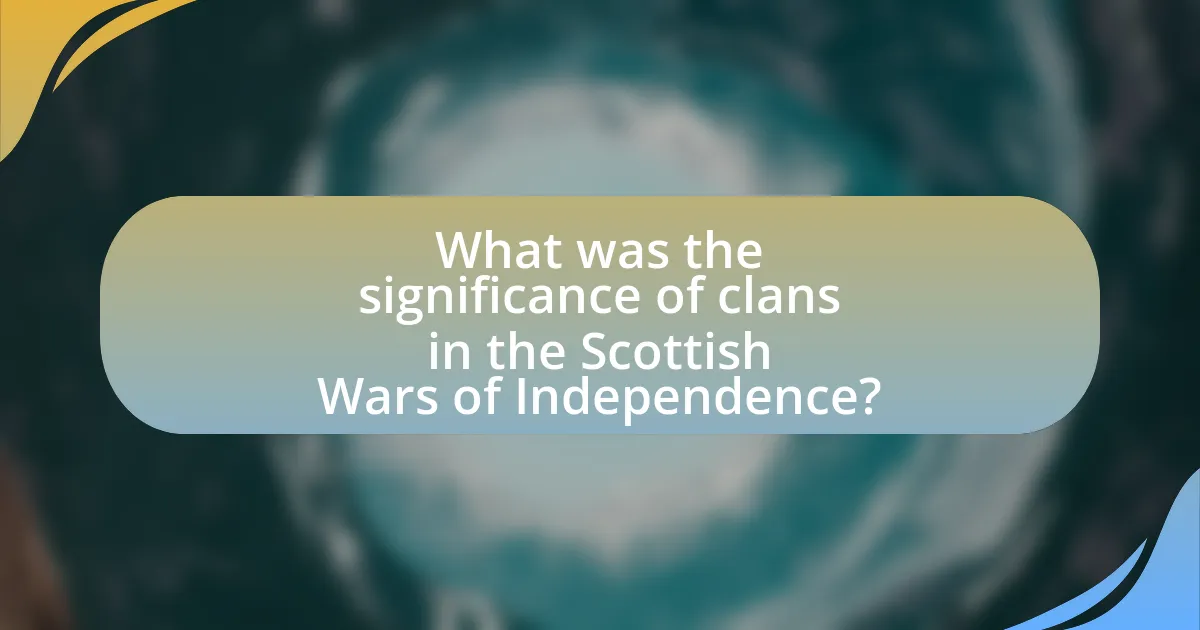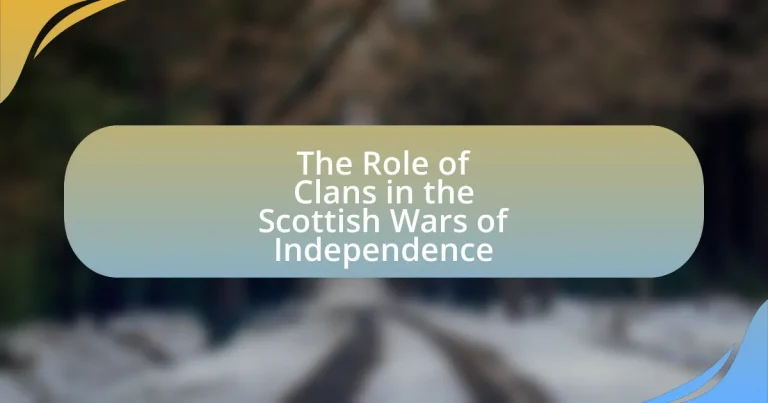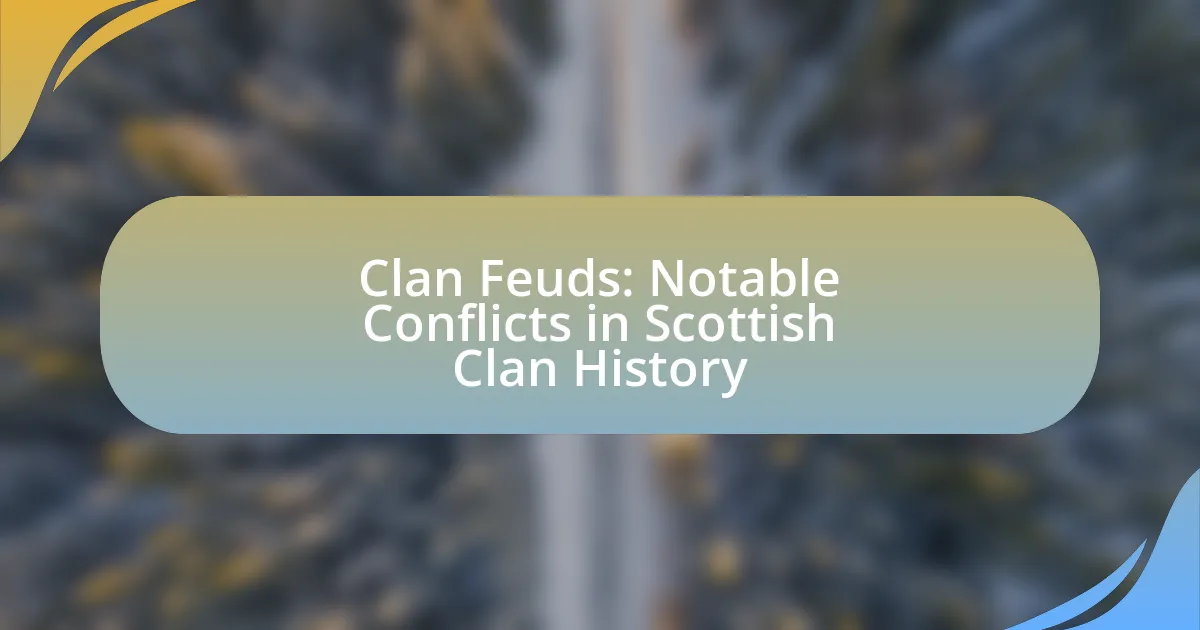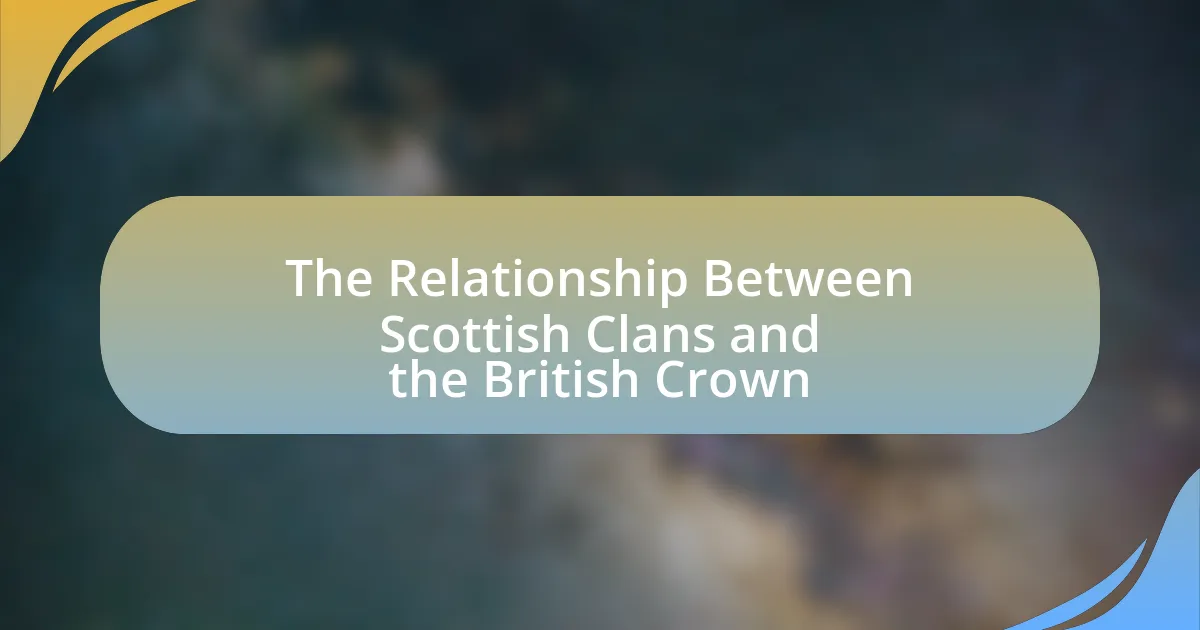The article examines the pivotal role of clans during the Scottish Wars of Independence, highlighting their significance as military and social units that mobilized support against English rule. It discusses how clan loyalty influenced political dynamics, the strategic contributions of clan leaders, and the shifting allegiances among clans throughout the conflict. Key clans such as the Wallaces, Bruces, and Macdonalds are identified for their contributions to major battles, while the article also addresses the challenges clans faced, including internal rivalries and external pressures from English forces. Additionally, it explores the lasting impacts of the wars on clan identities, culture, and the lessons modern organizations can learn from clan dynamics in conflict resolution and leadership.

What was the significance of clans in the Scottish Wars of Independence?
Clans played a crucial role in the Scottish Wars of Independence by serving as the primary military and social units that mobilized support for the struggle against English rule. During the late 13th and early 14th centuries, clans provided soldiers, resources, and local leadership, which were essential for the resistance efforts led by figures such as William Wallace and Robert the Bruce. The loyalty of clan members to their leaders facilitated the organization of armies and the execution of strategic battles, such as the Battle of Bannockburn in 1314, where clan alliances were pivotal in achieving a decisive Scottish victory. This collective action of clans not only strengthened the military capabilities of the Scots but also fostered a sense of national identity and unity against a common enemy.
How did clans influence the political landscape during the wars?
Clans significantly influenced the political landscape during the Scottish Wars of Independence by acting as powerful social and military units that shaped allegiances and territorial control. The loyalty of clan members to their leaders often dictated the political alignments in the conflict, as clans rallied around figures like William Wallace and Robert the Bruce, who leveraged clan support to challenge English rule. For instance, the Clan Campbell’s shifting alliances impacted the balance of power in the region, while the Clan MacDonald played a crucial role in the resistance against English forces. These clan dynamics not only determined military strategies but also influenced negotiations and treaties, ultimately shaping the course of Scotland’s fight for independence.
What roles did clan leaders play in the conflict?
Clan leaders played crucial roles in the Scottish Wars of Independence by mobilizing their followers for military campaigns and forming alliances. They acted as local power brokers, rallying support for either William Wallace or Robert the Bruce, which significantly influenced the outcomes of battles such as the Battle of Stirling Bridge in 1297 and the Battle of Bannockburn in 1314. Their leadership was essential in organizing troops, securing resources, and maintaining loyalty among clan members, which was vital for sustaining the resistance against English rule.
How did clan allegiances shift throughout the wars?
Clan allegiances shifted significantly throughout the Scottish Wars of Independence due to changing political dynamics and leadership. Initially, many clans supported the Scottish crown against English rule, but as the wars progressed, allegiances often realigned based on local interests, power struggles, and the influence of prominent leaders. For instance, clans like the MacDougalls initially opposed Robert the Bruce but later shifted their support to him as he gained power and legitimacy, demonstrating how clan loyalty could be swayed by the fortunes of key figures. Additionally, the fluctuating success of military campaigns influenced clan decisions, with some clans switching sides to align with the victors, as seen when the Clan Campbell shifted allegiance during the conflicts to secure their own power and land.
What were the primary clans involved in the Scottish Wars of Independence?
The primary clans involved in the Scottish Wars of Independence were the Clan Wallace, Clan Bruce, Clan MacGregor, Clan Campbell, and Clan Murray. Clan Wallace, led by William Wallace, played a significant role in the early stages of the conflict, particularly during the Battle of Stirling Bridge in 1297. Clan Bruce, under Robert the Bruce, became pivotal in the later stages, culminating in his victory at the Battle of Bannockburn in 1314. Clan MacGregor and Clan Campbell also contributed to the resistance against English rule, while Clan Murray supported the Bruce cause. These clans were instrumental in shaping the course of the wars and the eventual establishment of Scottish independence.
Which clans were loyal to Robert the Bruce?
The clans loyal to Robert the Bruce included the Clan Campbell, Clan MacDougall, Clan Comyn, and Clan Fraser. These clans supported Bruce during his struggle for Scottish independence, particularly in battles such as the Battle of Bannockburn in 1314. Their loyalty was crucial in consolidating Bruce’s power and advancing the cause of Scottish independence against English rule.
What was the role of the Macdonalds in the wars?
The Macdonalds played a significant role in the Scottish Wars of Independence by aligning with Robert the Bruce and participating in key battles. Their involvement was crucial during the early 14th century, particularly at the Battle of Bannockburn in 1314, where they contributed to the Scottish victory against the English forces. The Macdonalds, as one of the largest clans in Scotland, provided essential military support and resources, which helped solidify Bruce’s claim to the Scottish throne and resist English domination. Their actions during this period exemplified the importance of clan alliances in the broader struggle for Scottish independence.
How did clan warfare tactics impact the outcomes of battles?
Clan warfare tactics significantly influenced the outcomes of battles during the Scottish Wars of Independence by emphasizing mobility, surprise, and the use of terrain. Clans often employed guerrilla tactics, which allowed smaller groups to engage larger forces effectively, as seen in the Battle of Stirling Bridge in 1297, where William Wallace’s forces utilized the narrow bridge to their advantage, defeating the English army. Additionally, clan loyalty and the ability to quickly mobilize local fighters provided a strategic edge, enabling clans to respond rapidly to threats and exploit weaknesses in enemy formations. The effectiveness of these tactics is evidenced by the repeated successes of clan leaders like Wallace and Robert the Bruce, who capitalized on their intimate knowledge of the Scottish landscape and the element of surprise to achieve significant victories against more heavily armed opponents.
What strategies did clans employ in battle?
Clans employed various strategies in battle, including guerrilla tactics, ambushes, and the use of terrain to their advantage. These strategies allowed clans to leverage their knowledge of the local landscape, enabling surprise attacks and quick retreats. For instance, during the Scottish Wars of Independence, clans like the MacDonalds and the Campbells utilized their familiarity with the Highlands to execute ambushes against English forces, effectively disrupting larger, more organized armies. Historical accounts, such as those documented in “The Scottish Wars of Independence” by Chris Brown, illustrate how these tactics contributed to the clans’ successes in key battles, showcasing their adaptability and strategic prowess in warfare.
How did clan formations differ from traditional armies?
Clan formations differed from traditional armies primarily in their structure and operational tactics. Clans were typically composed of extended family groups led by a chief, emphasizing loyalty and kinship, while traditional armies were organized hierarchically with a clear chain of command and professional soldiers. Clans often engaged in guerrilla warfare, utilizing their intimate knowledge of the local terrain, whereas traditional armies relied on formal battle strategies and formations. Historical evidence from the Scottish Wars of Independence illustrates that clan leaders could mobilize their men quickly for raids or defensive actions, contrasting with the slower mobilization of traditional armies that required extensive planning and coordination.
What challenges did clans face during the Scottish Wars of Independence?
Clans faced significant challenges during the Scottish Wars of Independence, primarily due to internal divisions and external pressures. Internal conflicts among clans often led to fragmented loyalties, making it difficult to present a united front against English forces. For instance, rivalries between clans such as the Campbells and the MacDonalds weakened collective resistance efforts. Additionally, the English crown’s military superiority and strategic alliances with certain Scottish clans further complicated the situation, as some clans chose to side with the English for personal gain or protection. The harsh realities of warfare, including loss of life and resources, also strained clan capabilities, hindering their ability to sustain prolonged resistance against English domination.
How did internal clan rivalries affect their effectiveness?
Internal clan rivalries significantly diminished the effectiveness of clans during the Scottish Wars of Independence. These rivalries often led to fragmented loyalties, where clans prioritized their own interests over collective action against external threats, such as the English crown. For instance, the feud between the Clan Campbell and Clan MacDonald resulted in a lack of unified resistance, weakening their overall military strength and strategic coordination. Historical accounts indicate that such divisions not only hampered joint military efforts but also allowed the English forces to exploit these internal conflicts, ultimately undermining the clans’ ability to present a cohesive front in the struggle for Scottish independence.
What external pressures did clans encounter from the English forces?
Clans encountered significant external pressures from English forces during the Scottish Wars of Independence, primarily through military invasions and territorial encroachments. The English crown, under leaders like Edward I, sought to assert control over Scotland, leading to battles such as the Battle of Falkirk in 1298, where English forces defeated the Scots, further destabilizing clan territories. Additionally, English policies aimed at subjugating Scottish clans included punitive raids and the imposition of heavy taxes, which strained clan resources and loyalty. These pressures forced clans to either align with or resist English authority, significantly impacting their autonomy and influence in the region.
How did the Scottish Wars of Independence shape clan identities?
The Scottish Wars of Independence significantly shaped clan identities by fostering a sense of loyalty and unity among clans against a common enemy, primarily the English crown. During the wars, clans rallied around their leaders, which solidified their social structures and reinforced their distinct identities. The conflicts, particularly the battles of Stirling Bridge in 1297 and Bannockburn in 1314, highlighted the importance of clan allegiance and local leadership, as clans such as the Campbells and the MacDonalds played pivotal roles in these battles. This period also led to the emergence of clan tartans and heraldry, further distinguishing clan identities and fostering a sense of pride and belonging among members.
What lasting impacts did the wars have on clan loyalty?
The wars significantly strengthened clan loyalty as clans united against a common enemy, fostering a sense of solidarity and shared purpose. This unity was crucial during the Scottish Wars of Independence, where clans like the Campbells and the MacDonalds rallied to support leaders such as William Wallace and Robert the Bruce. The aftermath of the wars solidified these alliances, as clans recognized the importance of collective strength for survival and influence in a politically fragmented landscape. Historical records indicate that post-war, clan allegiances became more pronounced, with loyalty often dictated by shared military experiences and the need for mutual defense against external threats.
How did the wars influence clan culture and traditions?
The wars significantly influenced clan culture and traditions by reinforcing loyalty, kinship, and martial values among clan members. During the Scottish Wars of Independence, clans rallied around their leaders, fostering a sense of unity and identity that was crucial for survival against external threats. This period saw the emergence of clan-based military structures, where loyalty to the clan chief became paramount, shaping social hierarchies and governance within clans. Additionally, the wars led to the establishment of clan symbols and tartans, which became integral to clan identity and pride, further solidifying cultural traditions that emphasized bravery and honor in battle. Historical records indicate that clans like the MacDonalds and the Campbells played pivotal roles in battles such as Bannockburn, which not only showcased their military prowess but also deepened their cultural significance within Scottish society.
What lessons can be learned from the role of clans in the Scottish Wars of Independence?
The role of clans in the Scottish Wars of Independence teaches the importance of unity and loyalty in achieving collective goals. Clans, such as the Macdonalds and the Campbells, played crucial roles in mobilizing local support and resources, demonstrating that strong social structures can significantly impact military outcomes. Historical events, like the Battle of Bannockburn in 1314, highlight how clan alliances were pivotal in securing victories against English forces, showcasing the effectiveness of coordinated efforts among diverse groups. This illustrates that cohesive community support can enhance resilience and effectiveness in times of conflict.
How can modern organizations apply clan strategies in conflict resolution?
Modern organizations can apply clan strategies in conflict resolution by fostering a strong sense of community and shared identity among team members. This approach encourages collaboration and mutual support, which are essential for resolving disputes effectively. For instance, organizations can implement team-building activities that emphasize trust and open communication, similar to how Scottish clans relied on kinship ties to maintain unity during conflicts. Research indicates that organizations with a strong communal culture experience lower levels of conflict and higher levels of employee satisfaction, as seen in studies by the Harvard Business Review, which highlight the benefits of cohesive team dynamics in conflict resolution.
What insights do clan dynamics provide for contemporary leadership?
Clan dynamics offer valuable insights for contemporary leadership by emphasizing the importance of loyalty, shared identity, and collective decision-making. In historical contexts, clans operated on strong kinship ties and mutual support, which fostered resilience and unity during conflicts such as the Scottish Wars of Independence. This model illustrates that effective leadership today can benefit from cultivating a sense of belonging and trust among team members, leading to enhanced collaboration and commitment. Research indicates that organizations with strong internal cultures, akin to clan dynamics, experience higher employee engagement and lower turnover rates, demonstrating the relevance of these principles in modern leadership practices.





